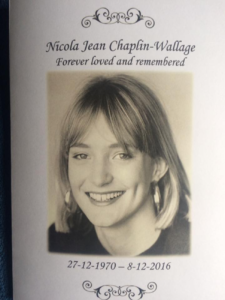
Survivors of suicide loss take different routes to find comfort and healing along the grief journey. Today, guest author Chris Chaplin, CST-T shares about the difficult experience of losing his sister and transformational moment of CranioSacral therapy that provided significant progress in his recovery. I resonated with this post because I have found it helpful to try Reiki, acupuncture, hypnotherapy and other forms of alternative treatment and “body work” to cope with the loss of my dad.
My Journey after My Sister’s Suicide, Chris Chaplin CST-T
Suicide seems to be one of the most devastating events in a family’s life. The repercussions just never seem to end, so how does one overcome it? This is my story about my sister’s suicide and my journey since then including the CranioSacral therapy that I received.
Nicky was a lovely soul and an angel, but that was when she was well. She had a flip side to her as well and that was the angry, hurtful, mean person that she could be. She was bipolar; bipolar disorder, also known as manic-depressive illness, is a brain disorder that causes unusual shifts in mood, energy, activity levels, and the ability to carry out day-to-day tasks. – Definition by National Institute for Health.
She would be your best friend one day and then suddenly not talk to you for weeks or months on end. Then, suddenly, you were back to being the best thing in her life. It was a tough ride, but one the family got used to dealing with. It took its toll, but in a completely different way than her eventual suicide. She had many ups and downs in life but was, when all is said and done, a beautiful, caring, loving and successful person. However, she was hugely unhappy and troubled all at the same time.
When Life Changed Forever
I live in San Diego and Nicky lived in Johannesburg, South Africa where I am originally from. A few days before we were due to go to South Africa on vacation in December 2016, I was called by my father and told that Nicky had taken her life. It hit me in a way that I never expected. I mean, in one way I suppose I always expected her to take her own life as she had tried a number of times before. But it still shook my world.
I felt guilty for not having done more to keep in contact, for not following up with her after hearing that she had gotten divorced, for not inviting her to spend time with me when we were going to be in South Africa and the list goes on. I felt a huge loss as one can only feel when one loses a loved one and knows that you can’t ever speak to them in person again. I felt dead inside and wasn’t able to let it out. How does one talk about this? I felt alone as I was so busy trying to help everyone else through this tough time that I was not helping myself. Because of that, I didn’t really help everyone else. We were all pretending to be okay.
During the trip, we spoke about Nicky but we were all hurting so much that we tried to enjoy our time together between the tears that inevitably poured. I remember going to a small chapel at the crematorium and it being only a few of us there. I put my hand on the coffin and sent Reiki energy to her and wished that she was now in a space where she was happy.
It was a trip that had many moments of happiness and enjoyment, but it was also a holiday of holding myself and others together as much as possible. I balanced tears with trying to enjoy this visit that I had long been looking forward to for different reasons.
Ready To Begin Grief Work
We would come back from vacation and the emotions were still raw. I had seen my mother and father age, and my older sister was inconsolable. I was dealing with the grief of everyone else on top of my own feelings. I was torn up as Nicky and I had not spoken in a long time and I was feeling guilty for whatever part I felt I had played in her taking her life. I was filled with grief and the worst part was I couldn’t remember anything about Nicky. It was as though my mind had shut off and erased the good and the bad times we had spent together. As the days went by, weeks became months and I was struggling. I felt like taking my own life.
I went for counseling, wrote in a journal and tried to get back into the swing of things. It was hard as every time I phoned either of my parents or my sister, I was reminded of the depth of this loss and sent spiraling downward. I had to be strong for everyone, but inside I was broken and could not see my way out. I was feeling more and more suicidal and it took all I had to get out of bed and to put on a seemingly happy face each day.
Healing Through CranioSacral Therapy
One forgets to do the basics during a time like this. Coming from the background that I do with Reiki, CranioSacral therapy and massage, one would think that I would look to those modalities and others to help me through. But, it seemed that I needed someone to offer to help me and not for me to figure it out. I had signed up for an advanced CranioSacral class for August but then asked to move it to April. The gods must have intervened because I was initially far down the waitlist and the next thing I know I was accepted into the class.
CranioSacral Therapy (CST) is a gentle, hands-on approach that releases tensions deep in the body to relieve pain and dysfunction and improve whole-body health and performance. It was pioneered and developed by Osteopathic Physician John E. Upledger after years of clinical testing and research at Michigan State University where he served as professor of biomechanics.
Using a soft touch which is generally no greater than 5 grams – about the weight of a nickel – practitioners release restrictions in the soft tissues that surround the central nervous system. CST is increasingly used as a preventive health measure for its ability to bolster resistance to disease, and it’s effective for a wide range of medical problems associated with pain and dysfunction. – Definition by Upledger Institute.
The class has a lot to do with SomatoEmotional Release – a therapeutic process that uses and expands on the principles of CranioSacral Therapy to help rid the mind and body of the residual effects of trauma. – Definition by Upledger Institute.
The class is set up to work in groups and in my particular class there were three groups of four people. We would each get a turn as a client, lead therapist and support therapist for each day of the class over the course of five days. We started at 9:00 am and ended between 11:00 pm and 1:00 am every day. It was intense and tiring and transformational for each one of us.
CranioSacral therapy and Somato Emotional Release are really client focused and client-led therapies. The client and their inner wisdom lead the sessions and the therapist(s) are really facilitators who help the client. They do not lead the client but instead follow the client’s body, tissues and dialogue in helping release whatever restrictions and stored emotions that come up during a session. The client has to take responsibility for themselves and their healing journey.
Personally, I had stored so much emotion in my body and was holding onto emotions that weren’t reasonable for me to do. The guilt I felt was probably typical in that everyone wonders what they could have done differently. At the end of the day, suicide is devastating to everyone who is affected by it and to me, I was emotionally exhausted.
My time on the table was unique in so many ways. I learned so much from it as a person and as a therapist. On the first day, I cried. I struggled to breathe, I struggled to talk, I felt helpless, guilty and sad. I wanted to feel that way and not be told that it wasn’t my fault or that time would heal and that Nicky was in a better place. I was on the table for a long time and it was only when one of the therapists wanted to make me feel better that it dawned on me that I didn’t want to feel better. It was at that point that I realized that no matter what I wanted as a therapist, I needed to just be with my clients. It was a huge lesson for me to learn that if the client feels bad, that it is not my job to make them feel better. I got off the table and felt all of those emotions and let myself just feel them. It allowed me to feel all of my emotions without having to guard them from others as well as from myself.
It was different for me than most clients as they would not then have to ground themselves, become neutral and work as a therapist for another client, which is what I had to do. I was the support therapist for the next two sessions. I had been the lead therapist the session before mine.
The next morning and each subsequent morning, we gave feedback on each session in order of the sessions from the day before. The format of the feedback was first from the point of view of the client, then the lead therapist and then the support therapists. It was where a lot of learning happened as well as more processing. If I got triggered by what someone else said, I understood that it was something within me that I was responding to which gave me an opportunity to work on it so as not to be triggered again.
Each and every day was emotional for me, in processing the previous day as well as my time on the table. Each day brought about new revelations for me and I forgave myself and I forgave Nicky for taking her life. I remembered the bad times we had and eventually remembered the good times. I felt her presence in the room and knew that she was fine and that I no longer needed to worry about her. I let go of so many emotions and gave myself permission to just grieve her death and not to have to hold it together anymore. It gave me a sense of freedom and I felt a level of sanity return to me. I slept better than I had in months; my headaches had diminished in frequency and intensity. The therapy didn’t take away her death but helped me cope in a better way and to release many of the thoughts I had been having. I had been feeling suicidal before the class began and by the time the week was over I no longer felt that way. For me, it turned my life around when I needed it most.
Suicide is something that can never be undone nor in my experience fully understood. I may never know why Nicky killed herself but what I do know is that for us as a family, we have rallied around each other as best we can even though we will never be the same again. We all lost a part of ourselves in the death of someone who meant so much to each of us, and it doesn’t matter whether we were on good terms or not. We still hurt just as much. This has taught me to take nothing for granted and to appreciate each and every person in my life in a completely different way.
Call your local suicide hotline if you ever have suicidal thoughts. Seek out traditional Western medical help as well. I hope my story helps you whether you are suicidal or living with the after effects of someone you knew having committed suicide.
For more information about CranioSacral therapy go to the Upledger Institute’s website at www.upledger.com




Thank you. Feb. 5 will be the 1-year anniversary of my sister’s suicide. Kathy was also bipolar so I can relate to a lot you say in the article. Thank you for sharing. Besides 10-week support group I am finding acupuncture of much help. Suicide is a massive epidemic, unfortunately, but there is HOPE and resources available to survivors. Again, thanks for sharing.
Thanks for sharing. My ex spouse took his own life. We were talking about our future and possibly getting back together the night before. Yoga and exercise are helping me to heal. I will never know why he took his life. All i have is some good memories and hope that h e is in a better place.
Thanks for sharing Chris…Depression and Suicide ARE REAL, and they ‘HURT’ us all. I too have worked and come to ‘terms’ with this beautiful work of craniosacral therapy….I will pray that more people find a craniosacral therapist that is able to ‘hold space’ for them…our bodies are amazing…Be Proud, and grateful that you stepped out…with this article, you will NEVER know how many lives you have changed/saved…Wishing you endless Blessings, 🙂
Thank you for sharing. It is so hard, as we try to figure out the why and will never know, until we meet again…… I am thinking of you and your family and know that is important to be there for each other. The best thing we can do is be there for each other. Give lots of hugs!
Thank you for sharing your pain, journey and eventually a way to cope in the aftermath of your sister’s suicide.
I lost my sister to suicide in November of 2016. It’s a devastating and horrible tragedy that we are forced to live each and every day. For me it’s also been a constant sifting through conversations and details trying to determine if I was part of her reason for suicide otherwise, wouldn’t she still be here? I will never be able to “fix” this awful tragedy.
It’s helpful to hear about alternative therapies especially because what may be working today may not work tomorrow. Thank you.